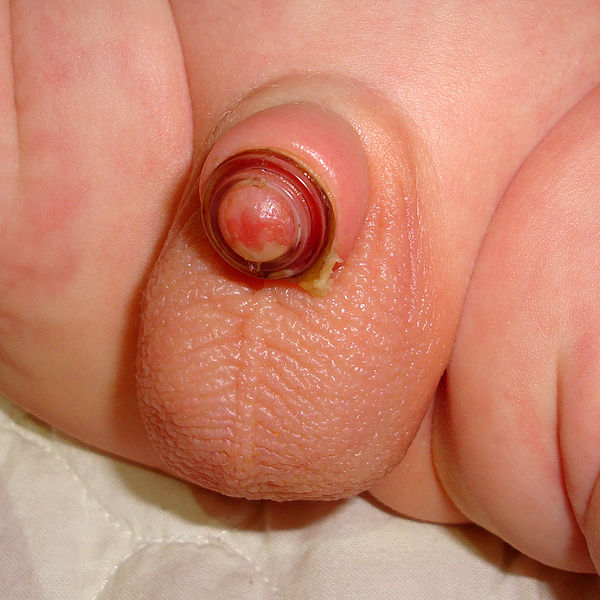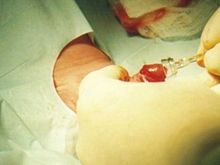Plastibell
 The Plastibell Circumcision Device is a clear plastic ring with a deep groove running circumferentially designed for circumcising infant males. The Plastibell is placed onto the head of the penis during a 10 minute surgical procedure, and the device will fall off within 3 to 7 days. The Plastibell was invented by Hollister Inc in 1950, and first reported on in 1953
The Plastibell Circumcision Device is a clear plastic ring with a deep groove running circumferentially designed for circumcising infant males. The Plastibell is placed onto the head of the penis during a 10 minute surgical procedure, and the device will fall off within 3 to 7 days. The Plastibell was invented by Hollister Inc in 1950, and first reported on in 1953 |
Surgical description The Plastibell Circumcision Device is a clear plastic ring with handle designed for male neonatal circumcision that has a deep groove running circumferentially. The elective minimally invasive surgical procedure to install the Plastibell device may be performed by an OB/GYN, a pediatrician, a urologist, a family physician or a pediatric surgeon. The important issue is that the medical practitioner is trained in the procedure.
The adhesions between glans and foreskin are divided with a probe. Then the foreskin is cut longitudinally to allow it to be retracted and the glans (the head of penis) to be exposed. The Plastibell comes in 6 sizes. The appropriate one is chosen and applied to the head (the circumcision pictured at right is in this stage). The ring is then covered over by the foreskin. A ligature is tied firmly around the foreskin, crushing the skin against the groove in the Plastibell. Then the excess skin protruding beyond the ring is trimmed off. Finally, the handle is broken off at the end of the procedure. The entire procedure takes five to ten minutes, depending on the experience and skill of the surgeon.
The Plastibell Circumcision Device is a clear plastic ring with handle designed for male neonatal circumcision that has a deep groove running circumferentially. The elective minimally invasive surgical procedure to install the Plastibell device may be performed by an OB/GYN, a pediatrician, a urologist, a family physician or a pediatric surgeon. The important issue is that the medical practitioner is trained in the procedure.
The adhesions between glans and foreskin are divided with a probe. Then the foreskin is cut longitudinally to allow it to be retracted and the glans (the head of penis) to be exposed. The Plastibell comes in 6 sizes. The appropriate one is chosen and applied to the head (the circumcision pictured at right is in this stage). The ring is then covered over by the foreskin. A ligature is tied firmly around the foreskin, crushing the skin against the groove in the Plastibell. Then the excess skin protruding beyond the ring is trimmed off. Finally, the handle is broken off at the end of the procedure. The entire procedure takes five to ten minutes, depending on the experience and skill of the surgeon.As with all circumcisions, the procedure should involve adequate anaesthesia, using either EMLA cream,[4] dorsal penile nerve block, penile ring block, or a combination of these prior to operation. The ring falls off in 3 to 7 days leaving a circumferential wound that will heal over the following week. Typically, the glans will appear red or yellow until it has cornified. |
AdvantagesThe glans is protected during the procedure by the ring. Hemostasis (control of bleeding) is effective due to the ligature tie. Cosmetically, a predictable result is obtained due to the straight line of the ligature that causes the wound. It is a quick procedure for the physician to perform-once mastered.No bandage is required, allowing easy monitoring for infection. Healing occurs while the edges of the prepuce are secured in the ring, making skin bridges (where the foreskin's end heals to the glans' corona) unlikely. Cosmetically, there will be little to no circumcision scar, though as usual with any circumcision, there will be a color change where the (formerly) inner and outer layers of foreskin meet. |
DisadvantagesThe ring must fall off before final healing can occur. Rarely, the tip of the glans may protrude through the ring and become swollen, trapping the ring in place. Blood transfusion risk 1 in 30,000 procedures (Wiswell).[citation needed]One study of 2000 Plastibell circumcisions found a complication rate of 1.8%. The foreskin must be slit and forced from the glans to allow entry for the plastic dome. Furthermore, because convalescence depends on a (temporarily) affixed medical device, risks of infection or hemorrhage due to the bell slipping or otherwise failing are greater than a Gomco clamp or similar entirely-supervised circumcision. There are several reports in the literature of urinary retention after circumcision with the Plastibell device. Death has been reported. There also is a report of impetigo caused by Staphylococcus aureus when using the Plastibell. There have been multiple cases of children developing necrotizing fasciitis in their penis after being circumcised using the Plastibell device. There have been cases of necrosis of the glans penis following circumcision with the Plastibell device. |